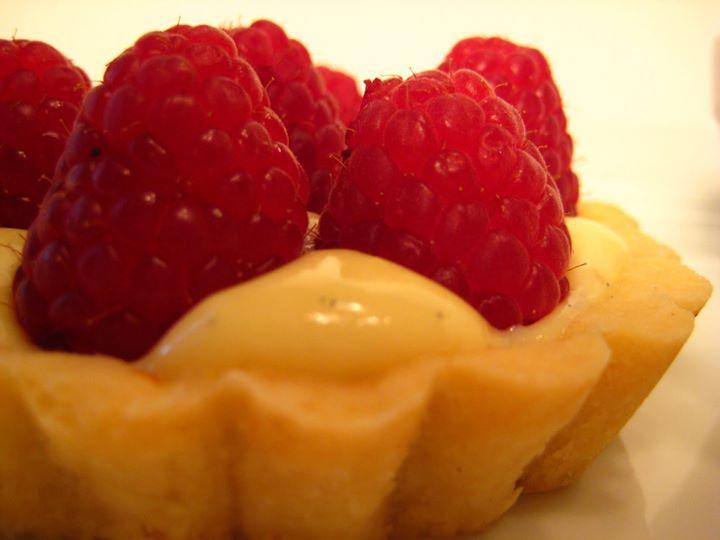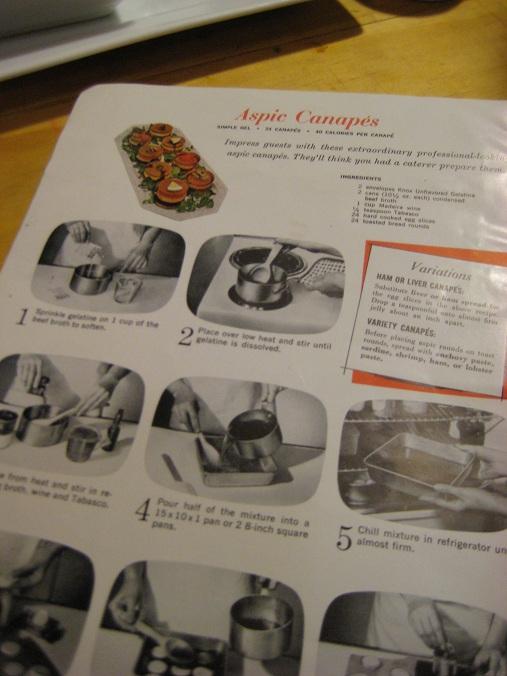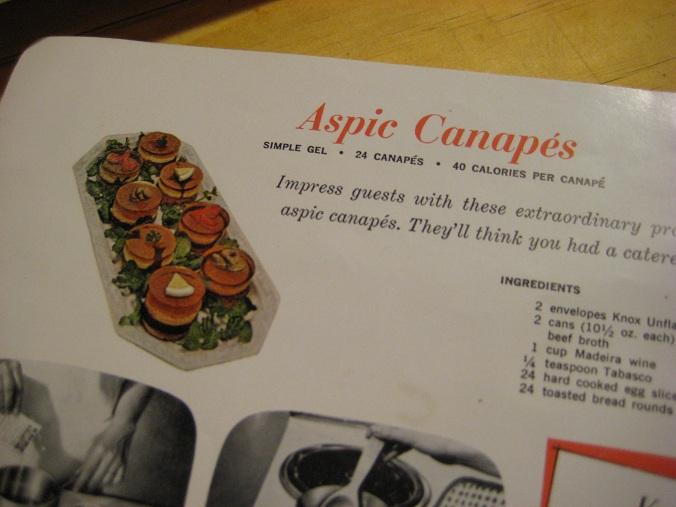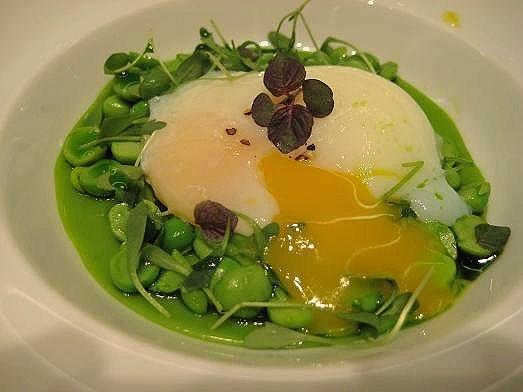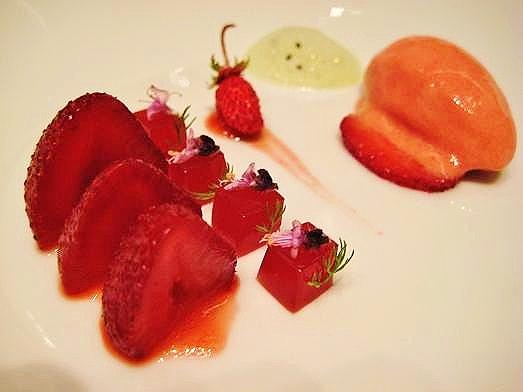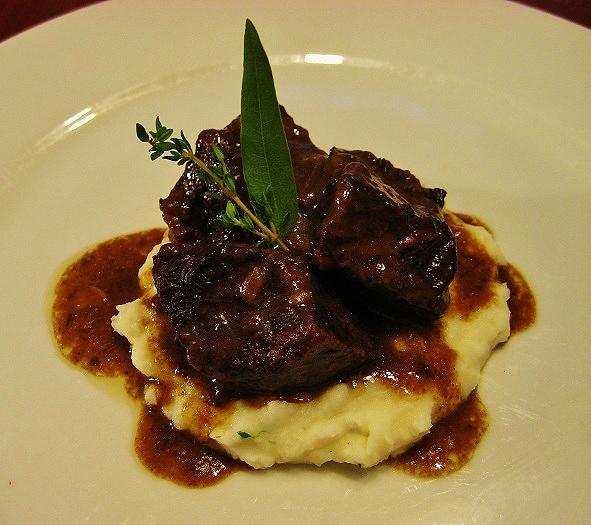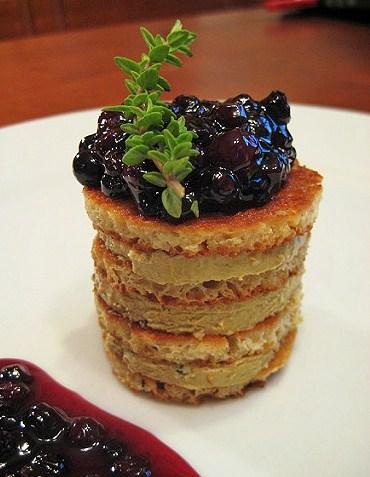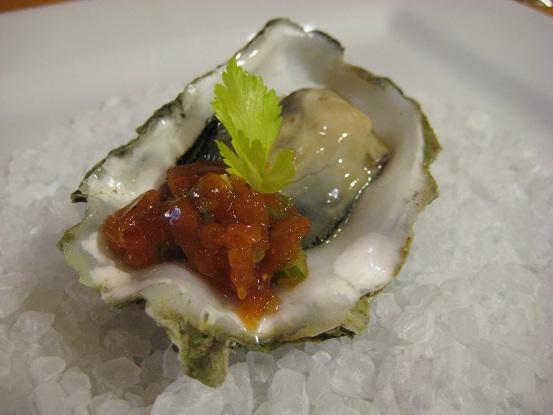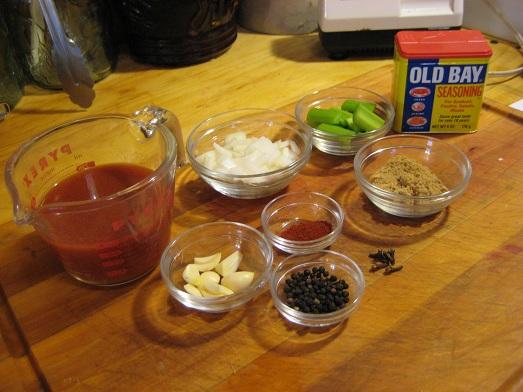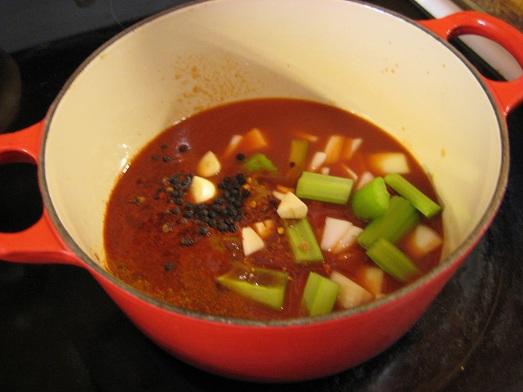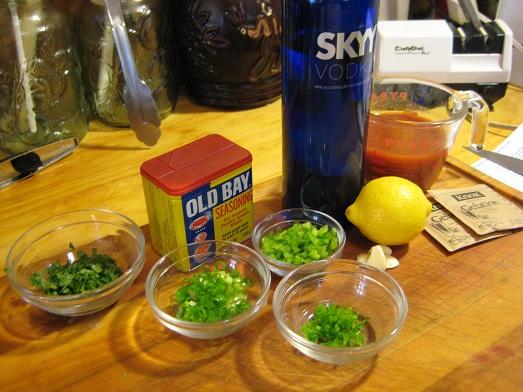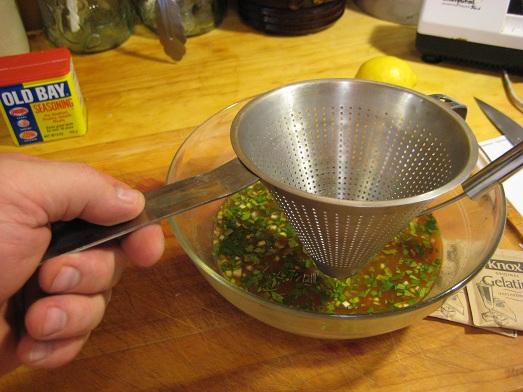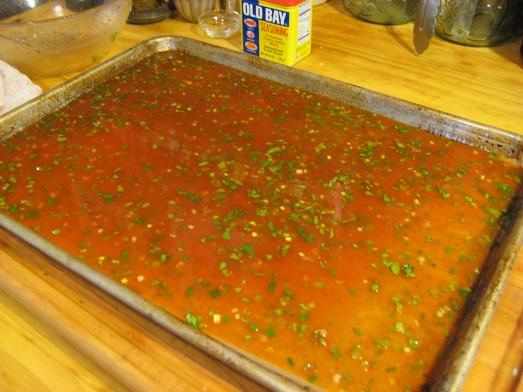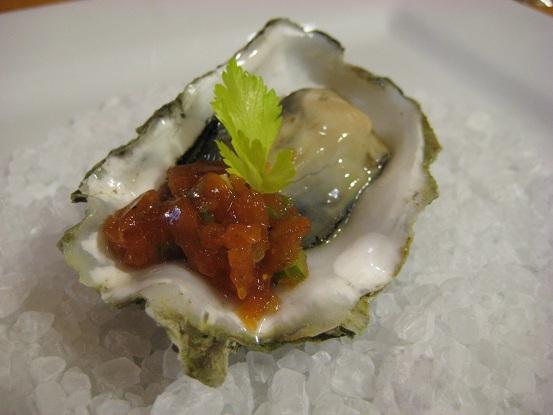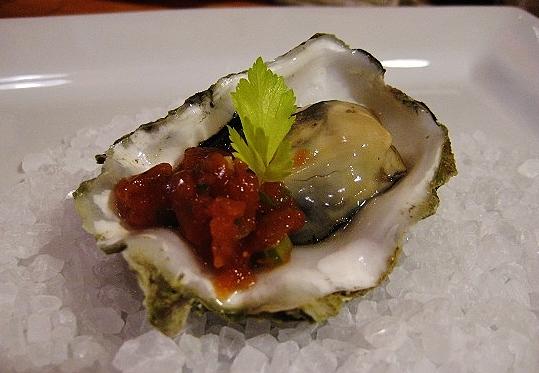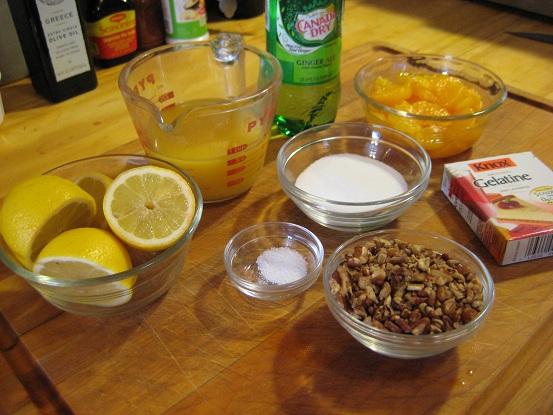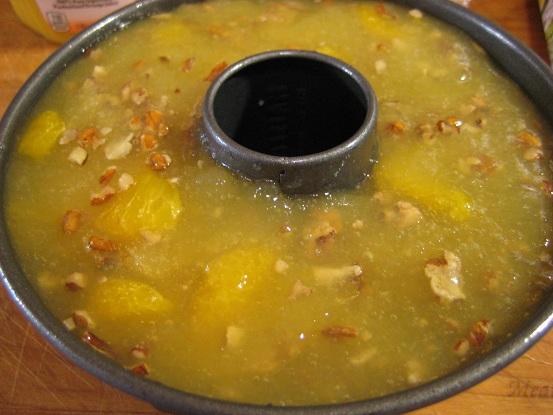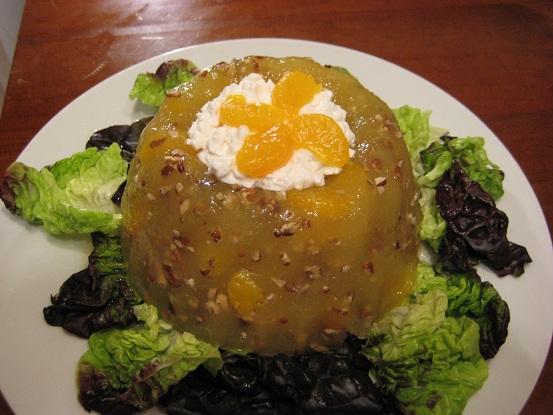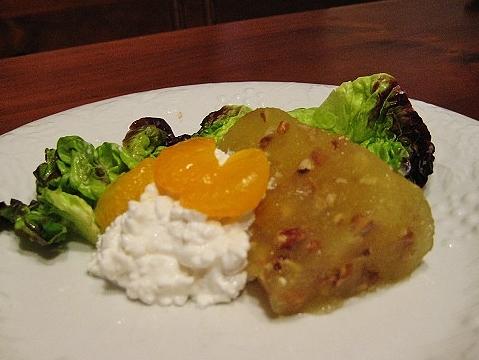-
Posts
5,035 -
Joined
-
Last visited
Content Type
Profiles
Forums
Store
Help Articles
Everything posted by David Ross
-
I've named my next gel dish "Foie Gras Mousse in Ice Wine Jelly with Huckleberry Compote." I'll start with a description of each of the elements that went into the dish- -The foie gras mousse is from D'Artagnan. I could never, ever, create a mousse of foie gras with black truffle as unctuous, silky and memorable as what I can buy from D'Artagnan. I typically treat myself to only one shipment a year each Fall. But owing to my dedication to this Cook-Off, I ordered two shipments of Foie Gras. (All in the interest of culinary experimentation of course). After tasting this little tidbit, I welcome any Anti-Foie faction to come to my house and have a taste. You will lift the ban within minutes. -The Ice Wine Jelly was composed of 1 1/2 cups of wine and 1 1/2 tsp. of powdered, unflavored gelatine. To keep with a Northwest theme, (the other Northwest element being the huckleberries), I chose a 2009, Tefft Cellars, Black Ice, Black Muscat, from the Yakima Valley of Central Washington. I heated the wine to a gentle simmer then stirred in the gelatine. The "first layer" was poured into the mold about 1/2" deep, then chilled to set. The "second layer" was a medallion of the foie gras, then a "third layer" of more of the gel. For the "third layer" I used cooled gelatine that wasn't set. I didn't want to use hot gelatine that could have melted the foie gras. -I am one of the most fortunate cooks in the world. I live literally a few miles from the high mountain meadows where wild huckleberries flourish. Every year in late summer I gather about two gallons of the tart, fragrant berries. I immediately make two things-a huckleberry pie and huckleberry compote. Ligonberries are nice and an ode to Scandanavia, cranberries fully appropriate and blueberries pedestrian in a compote. But no other berry is like a huckleberry. When made into a compote and served with the season's first wild Scottish grouse or spooned onto a piece of toast with bleu cheese, you enter into a state of utter huckleberry pleasure. Should you be able to get them, fresh huckleberries are best. You can find online sources for frozen huckleberries. Combine all of these ingredients in a saucepan and bring just to the boil. Reduce the heat to a simmer and cook for about 30 minutes. The compote will thicken as it cools. It's best kept for a day, covered, in the refrigerator, before serving. Gently warm the compote just before service. 1/4 cup red wine 1 tbsp. balsamic vinegar 1 1/2 cups huckleberries 1/8 tsp. cinnamon 1/8 tsp. grated nutmeg 3/4 cup granulated sugar 1 tbsp. fresh lemon juice -The bread came from Walmart. Yes, the bakery at Walmart supplied the bread for a dish featuring foie gras. I am, I am sure, the only man in America, the world perhaps, to pair bread from Walmart with a culinary icon. I bought a thick loaf of Italian herb bread. Dried it on the counter for a day, then used an old trick I found for cutting bread in very, very, thin slices--a meat slicer. Yes, the deli-style meat slicer works incredibly well for slicing bread into thin slices--the perfect accompaniment to foie gras, cheese or any soft terrine. After slicing the bread I brushed it with butter and toasted it in the oven until golden. -The herbs. I wanted to use thyme to play off my earlier photo of a past dish of a foie gras "sandwich" with layers of brioche croutons, foie gras and huckleberry compote. So thyme was a given. Then I found some fresh bay leaves that I bought a few days ago for the brine I'm using to marinate my Sauerbrauten, (that's for next week). A fresh sprig of bay, that seems like a nice garnish. Next up, some photos of the crafting of the gel in the mold, adding the foie gras, and unmolding the gel. Then plating, garnishing, and a cut-away view of what's in the heart of this little ice wine jelly.
-
Thank you for the suggestion. It worked! And....with Grandmother Pink's 100-year old metal Jell-O molds. Trust me, this wasn't a set-up from the start of the Cook-Off. I bought more silicone molds than I'll ever use in a lifetime. None of them worked as well as those little metal molds. I think everyone will be surprised at the photo results.
-

eG Foodblog - Dave Hatfield, La France Profonde
David Ross replied to a topic in Food Traditions & Culture
Dave, given your knowledge of cheese, what would you suggest for a three-cheese sampler plate for Thanksgiving, including garnishes/accompaniments? And two more cheese questions--what type of wine do you favor for a triple-cream and what type of wine with a bleu? -
Wow, what a lovely dish of pasta. Want to share the recipe?
-

eG Foodblog - Dave Hatfield, La France Profonde
David Ross replied to a topic in Food Traditions & Culture
Do you have squirrels in France? They love grabbing my black walnuts the minute they hit the ground. They store them all over the lawn and retrieve them in Winter. Huge old walnut tree and I end up buying walnuts! -
Worth pointing out, I think, that this and others like it (I have one similar) were aimed at the average housewife. Times have certainly changed. I thought the same thing. To a housewife in the 50's or 60's, making aspic canapes for a cocktail party was thought to be "fancy." But then you realize that these gels that were such a fad back then actually do have a relation, and cause for inspiration, for both home cooks and professional Chefs today.
-
You all thought I was scared off gels, didn't you? Hah! Fooled you! I've been wrestling with cups, plates, bowls and molds for the past few days now--still trying to figure out how to portray my Ice Wine Jelly, Foie Gras Mousse and Huckleberry Compote and do it justice. Oh, and I found another vintage cookbook, the "Knox-On-Camera Recipes, A completely new guide to Gel-Cookery." And this delicious-looking recipe for "Aspic Canapes," ca., 1962- "Impress guests with these extraordinary professional-looking aspic canapes. They'll think you had a caterer prepare them." Hmmm. Vintage. Retro. Little metal molds 90 years old. Aspic.........
-

eG Foodblog - Dave Hatfield, La France Profonde
David Ross replied to a topic in Food Traditions & Culture
I could easily be a hungry dog at your house. -
Thanks. It's the same basic recipe I always follow for braising beef-coat with flour, saute until deep brown, deglaze, add aromatics and liquid, then braise, covered, in a low oven. For this recipe I cut beef chuck into thick, 2" slabs-about 2 lbs. worth of meat. Then seasoned with salt and pepper and coated in 2 tbsp. flour. (Reserve the leftover flour for thickening the braising liquid). Sear the beef in a mix of butter and oil until deeply browned. (I use a LeCreuset deep casserole dish). Remove the beef then add more butter and olive oil and put in about 2 cups sliced yellow onions. Saute the onions until tender, not caramelized. Add 1-2 cloves garlic, 1 bay leaf, a few sprigs of thyme and some dried parsley. Add back the flour and stir, then deglaze with a bottle of dark stout beer. Add in 1 tbsp. molasses, (to add a sweet note to the bitter ale). Then add about 1 cup of beef stock. Cover and braise in the oven at about 300 temp for about 4 hours. Gently remove the beef chunks and strain the sauce back into the pot. Return the beef chunks and keep warm until service. At this point you can also put the beef in a separate container and refrigerate overnight. Then refrigerate the sauce until cold, skim off the top layer of fat, and combine with the beef on day two and heat through. Once the beef is ready for service, add in about 1 tbsp. of apple cider vinegar. It really gives a flavor boost and accents the sweet and sour in the stew.
-
This will be wonderful!
-
I recovered well. I took the foie gras mix and spread it on a slice of the brioche I bought to use as a crouton base for the dish. It was a darn good lunch for 11am on a Saturday. The Savoy dish takes you on a journey of different textures of peas. While there are subtle differences between the different textures of the peas-gelee, fresh, pea shoots-the essence of pea comes through in each element. I remember the gelee as very tender, not gummy or hard-set like I remember from eating packaged Jell-O. I've had this dish at Guy Savoy about three times now and I'm consistently amazed at how a Chef can make a pea taste so wonderful.
-
I've been struggling for hours and hours with how to capture the flavors and layers in my next dish-Foie Gras Mousse, Ice Wine Jelly, Huckleberry Compote, Crouton. I tried about every shape, size and type of mold I have...and nothing worked. The Foie Gras stuck to the mold and wouldn't come out. If the Foie Gras was at room temperature, it was like glue up against the side of the mold. Freeze the Foie Gras in the mold to make it easier to come out? Nope, little crystals of ice formed in the mousse and changed the silky texture we crave in Foie Gras. I'm challenged by the level of texture in each element--and how they stick to one another in the mold--jelly next to mousse, mousse next to compote, all touching the walls of a persnickety mold. I dipped the mold in warm water to loosen the mousse, then beat it against the counter and pushed a pairing knife around the edge of the mold. What finally came out looked more like dog food rather than something worthy of an eGullet Cook-Off. And then I remembered. I remembered this dish I tasted a few years back at a noted temple of French gastronomy. A restaurant smack dab in the middle of the desert in Las Vegas of all places. A dish crafted by the hands of a French Master. A man with Michelin Stars. A Chef who served me the ultimate taste of a humble ingredient grown in backyard gardens around the world. A dish with a layer noted on the menu as pea "gelee." I searched back in the archives and came upon my report on Vegas Uncork'd 2010-http://forums.egulle...s-uncorkd-2010/ In my report, this is how I described the vegetable course served at the "Master Series Dinner" at Guy Savoy restaurant in Caesar's Palace- First Course- "Tout Petits Pois"-Peas All Around Served with Pascal and Nicolas Reverdy, Les Coutes, Sancerre, 2007 "This is one of Chef Savoy's signature dishes. The base is a pea gelee, then you have pea jus, fresh Spring peas, pea shoots and a poached egg. The waiter cuts through the soft yolk once the dish is placed at the table. The bread for this course was a toasted country bread with chive oil. The taste is the essence of a garden of peas. Everyone at the table used the toast to soak up the pea and soft egg. Delicious." One of the dessert courses at the 2010 dinner at Guy Savoy was a masterful composition of different flavors and textures of strawberries, again using "gelee" as one of the elements. Fifth Course- "La Fraise-Strawberry Served with Clarendelle, Amberwine, Monbazillac, 2003 "The strawberries were served a number of ways-one small wild strawberry, poached strawberries, strawberry sorbet and strawberry gelee garnished with tiny little basil flowers and a small dollop of basil foam to the side. The herbal scent of the basil added to the sense one was eating fresh, sweet strawberries in the field." While I would like to think my food writing has progressed in the past two years, I know my skills with gels are still lacking. But with the inspiration from the memories of "Peas All Around" and "Strawberry," I'm putting Grandma Pink's little metal Jell-O molds back on the shelf, (for now), and I'm directing my dishes to different preparations. Once I've crafted Foie Gras, Ice Wine Jelly and Huckleberry Compote into something that looks and tastes delicious, I may move on to a sweet dish employing gels.
-
Flemmish Beef Stew. The flavor was good, but next time I'll use Guiness Stout in this stew as I prefer the stronger flavor over Belgian-style Ales.
-
Believe it or not, I'm hearing good reviews from Food Writers in Las Vegas about the new buffet at Caesar's Palace. It's sort of modeled on the buffet concept at the Wicked Spoon at the Cosmopolitan-small plates of food rather than groaning steam trays of tepid stuff. It might be worth a try. The next great opening with much loud fanfare will be late November or early December when Gordon Ramsay Pub opens in the former Bradley Ogden place at Caesar's. If you are looking for something on a more casual, less expensive level, you might want to try the Cafe at Valentino in front of the main dining room. I hear they just got in the season's first fresh white truffles from Alba. Chef Pellegrini's Pappardelle with White Truffles and a glass of wine is all you need for a delicious meal.
-
I've got everything to go for my next dish. Found a local Northwest ice wine that I'm going to use instead of Sauternes for the wine jelly in the dish. And I'll probably add a vinegar reduction on the plate. Wish me luck.
-
What I'd be tempted to do is work from the top of the mold to the bottom: -first layer: Fois gras mousse -second layer: Sauternes jelly, or if you're feeling very rich, perhaps a palmito mousse? You're looking for creamy and delicate flavours in this layer, if I'm reading you right. -third layer: huckleberry jelly (compote with gelatine, or perhaps try a hard-pectin set, sort of like PDF) -fourth layer: disc of brioche crouton, cut to shape. This is added when the huckleberry layer is almost but not entirely set, so that it sticks in well and becomes part of the mold, rather than simply a support. You'd come out with a triple-layer mold on a brioche base, sort of like how the best dessert mousses are set up (well, here at least); the crouton on the bottom will make it much easier to plate the final results, and will also give you just a hint of crunch in each bite, which looks like it was an essential part of the original dish. Thanks, you've described what I'm looking for to a "t." What is the flavor of palmito? I forgot to mention that the Foie Gras Mousse I use has chopped black truffles in it. Do you think the flavor of the truffle changes things in terms of the other gel layers? Palmito (heart of palm) is fairly difficult to describe. It's a delicate flavour similar to heart of celery but with faint tropical notes; the part used in the mousse is already quite soft and creamy, and combined with a hint of pimenton de la vera it's basically the vegetable equivalent of a really really good beschamel made with nata (the cream of the cream). It's normally sold as 4" long sections of heart in light brine to preserve it; for mousse one can either chop or puree the whole heart or cut it in half and use only the creamy center (which is what I do, and what the French would do - they regard the outer layers as somehow lacking, although those layers, being slightly more fibrous, are great in salads). I don't think that the presence of black truffle will change much in the way of the other gel layers, but it does convince me that palmito is the way to go in the cream layer, if you can source it. I keep forgetting that since Ecuador's a producer we've got palmitos coming out our ears, but the rest of the world regards it as a delicacy. Otherwise, Suaternes jelly will do well, or you could investigate making a heavy beschamel with shavings of truffle in it and gelling that with something like konjac or tapioca, neither of which seem to have issues with high-fat. Thanks for all the suggestions. I'll get to work on it this weekend.
-
What I'd be tempted to do is work from the top of the mold to the bottom: -first layer: Fois gras mousse -second layer: Sauternes jelly, or if you're feeling very rich, perhaps a palmito mousse? You're looking for creamy and delicate flavours in this layer, if I'm reading you right. -third layer: huckleberry jelly (compote with gelatine, or perhaps try a hard-pectin set, sort of like PDF) -fourth layer: disc of brioche crouton, cut to shape. This is added when the huckleberry layer is almost but not entirely set, so that it sticks in well and becomes part of the mold, rather than simply a support. You'd come out with a triple-layer mold on a brioche base, sort of like how the best dessert mousses are set up (well, here at least); the crouton on the bottom will make it much easier to plate the final results, and will also give you just a hint of crunch in each bite, which looks like it was an essential part of the original dish. Thanks, you've described what I'm looking for to a "t." What is the flavor of palmito? I forgot to mention that the Foie Gras Mousse I use has chopped black truffles in it. Do you think the flavor of the truffle changes things in terms of the other gel layers?
-
I'm lucky to have kept the older molds through the generations. When I see something in the kitchenware store, I buy it. I often don't use the molds for their intended purpose-say pastry. Often these little molds are perfect for garnishes, side dishes--and Jell-O!
-
As I move toward more contemporary dishes using gels, I need a few suggestions. Every Fall when the huckleberry crop shows its glory in our Farmer's Markets, one of the dishes I make is a batch of Huckleberry Compote. The Compote is incredibly delicious when paired with foie gras mousse and buttered brioche. The play of rich foie gras and tart, sweet huckleberries is a dish for the ages. I'm thinking of changing things up from my traditional presentation-layers of Brioche Croutons topped with alternating layers of Foie Gras Mousse, (pressed in a ring mold), then a spoonful of Huckleberry Compote on top. You could say this is an upscale version of a peanut butter and jelly sandwich. But I think I can take it to a new level employing gel techniques. Here's the traditional presentation- So if I prepared the ingredients in a mold, what would you think about these layers of flavors? -Bottom layer, Huckleberry Compote combined with gelatine. -Second layer, Sauternes Jelly? -Top layer, Foie Gras Mousse -Garnishes, Brioche, (Cut in wedges), Huckleberry Compote around the plate. The idea is to dip your spoon into the top layer of foie gras and the first taste is rich and decadent, then you sens the second layer of sweet, silky Sauterne, and a final layer burst of flavor from tart, fragrant huckleberries. Any suggestions or thoughts on the technique or flavor combinations?
-
Here's a fresh oyster paired with Bloody Mary Aspic. I made it as part of our latest Cook-Off here- http://forums.egulle...75#entry1892575
-
Borrowing again from the past, my second dish was based on a recipe I developed about 10 years ago-a marriage of all things delicious-vodka, tomato juice and oysters. I call it the "Bloody Mary Aspic." I thought about encasing the oyster in the aspic, but given the ruddy color of tomato aspic, the natural shape of the oyster wouldn't be visible. I thought about putting a little mold of aspic next to the oyster, but that didn't make sense because this is meant to be an oyster shooter-a one-shot gulp of oyster, aspic and Bloody Mary flavors. The next question was a simple one-how to garnish the oyster and the aspic. So relying on some people who know food, they simply pointed out what the traditional garnish is for a Bloody Mary-celery. The recipe starts with the basic two-step aspic process. First, I made a hot mixture of spicy tomato juice. The hot mixture was then blended into a cool mixture composed of gelatine and tiny diced vegetables. The ingredients are- 1 cup V8 Juice 1/2 cup chopped onion 1/3 cup chopped celery 1 tbsp. brown sugar 1/2 tsp. salt 2 cloves garlic, chopped 1/4 tsp. paprika 1/4 tsp. dried red pepper flakes 1 bay leaf 1 tsp. Old Bay seasoning 4 whole cloves Combine in a saucepan and bring to a boil. Reduce the heat and simmer for 10 minutes- While the first mixture is cooking, in another bowl combine- 2 envelopes unflavored gelatine 1/2 cup V8 Juice 1/2 cup clam juice 2 tbsp. fresh lemon juice 1/2 cup finely diced celery 1/2 cup vodka 1/3 cup chopped cilantro 1 tbsp. fresh ground black pepper 1 tbsp. finely diced fresh jalapeno Salt to taste Strain the hot liquid into the second bowl and stir to combine- Pour the tomato aspic into individual serving molds, (or in this case, spread it thin on a cookie sheet lined with parchment. Once the tomato aspic is chilled, you just scoop it off the cookie sheet and use it to garnish the oysters)- I used fresh Willapa Bay oysters that are harvested off the Oregon Coast. These little nuggets have a briny, salty, fresh sea taste-which pairs wonderfully with the spicy, rich, tang of the Bloody Mary Aspic-
-
Speaking of tomato aspic, I've got one to show everyone. I paired my tomato aspic with oysters-and it was delicious.
-
This was my first attempt, but that sounds like a good idea.
-
We'd love to hear more about this dish and the techniques.
-
My first dish for this Cook-Off is a 2012 version of the 1958 classic "Orange-Ginger-Ale Ring" taken from the Good Housekeeping Booklet. Grandmother Pink also had a recipe card for a gelled ginger ale salad which speaks to the popularity of this dish that was cheap, easy to make and tasted good. When you think about the combination of flavors and textures, it makes sense in a contemporary kitchen-Sweet orange citrus flavors with the punch of ginger and fizz. If you look at the list of ingredients in this dish, you start to think how you can adapt it for a modern presentation. This is the list of ingredients as written in 1958- Orange-Ginger-Ale Ring- 2 env. unflavored gelatine 1/2 cup fresh, frozen, or canned lemon juice 1/2 cup granulated sugar 1/2 tsp. salt 1 1/4 cups orange juice 2 cups ginger ale 2 cups orange sections 2/3 cup chopped pecans Cottage cheese Orange Slices Crisp greens The recipe is very basic-soften the gelatine in the lemon juice. Combine the sugar, salt, orange juice, ginger ale, orange sections and pecans in a saucepan. Heat until hot but not boiling, then add the softened gelatine. Combine this mixture in a ring mold. (I used a non-stick bundt cake ring mold). Chill the salad for about 2 hours until fully set then unmold and garnish with cottage cheese, orange slices and "crisp greens." (I used baby butter lettuce). I doubled the gelatine to 4 envelopes because I found the ratio of liquid to gelatine called for in the recipe didn't allow the mixture to gel. I also cut the 2 cups of orange sections by half to 1 cup. Now before you start to wince when you view these photos, let me say that this salad was delicious. You could really taste the flavors of the ginger ale. Surprisingly, you could also taste the carbonation of the ginger ale. I had anticipated that the fizz from the soft drink would fade when it was heated then chilled with the gelatine, but it retained a lot of that classic flavor. Ingredients- After about 2 hours chilled in the refrigerator- The salad as it would have looked on the 1958 buffet table- It won't make the annals of gel cookery, but it sure tasted good- I don't know why we shy away from buying little tubs of cottage cheese when we're in the supermarket. It's delicious and we should use it more in recipes. A few years ago I came across a recipe from famed French Chef Andre Soltner that called for substituting fresh Farmer's cheese with pureed cottage cheese. Imagine the fresh, mild flavor of cottage cheese in a silken form, (not the texture of small cheese curds). Maybe a layer of cottage cheese puree topped by a layer of orange-ginger ale gel encasing a poached chicken supreme?

